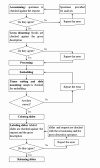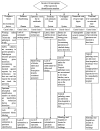Analysis of errors in histology by root cause analysis: a pilot study
- PMID: 24396989
- PMCID: PMC4718384
Analysis of errors in histology by root cause analysis: a pilot study
Abstract
Introduction: The study objective is to evaluate critical points in the process of pre-analytical histology in an Anatomic Pathology laboratory. Errors are an integral part of human systems, including the complex system of Anatomic Pathology. Previous studies focused on errors committed in diagnosis and did not consider the issues related to the histology preparation of routine processes.
Methods: Root Cause Analysis was applied to the process of histology preparation in order to identify the root cause of each previously identified problem. The analysis started by defining an 'a priori' list of errors that could occur in the histology preparation processes. During a three-month period, a trained technician tracked the errors encountered during the process and reported them on a form. 'Fishbone' diagram and 'Five whys' methods were then applied
Results: 8,346 histological cases were reviewed, for which 19,774 samples were made and from which 29,956 histologies were prepared. 132 errors were identified. Errors were detected in each phase: accessioning (6.5%), gross dissecting (28%), processing (1.5%), embedding (4.5%), tissue cutting and slide mounting (23%), coloring, (1.5%), labeling and releasing (35%).
Discussion: Root cause analysis is effective and easy to use in clinical risk management. It is an important step for the identification and prevention of errors, that are frequently due to multiple causes. Developing operators' awareness of their central role in the risk management process is possible by targeted training. Furthermore, by highlighting the most relevant points of interest, it is possible to improve both the methodology and the procedural safety.
Figures
References
-
- Kohn LT, Corrigan JM, Donaldson MS. To err is human: building a safer health system. Washington, DC: National Academy Press; 1999. - PubMed
-
- Sirota RL. Error and error reduction in pathology. Arch Pathol Lab Med. 2005;129:1228–1233. - PubMed
-
- Foucar E. Error in anatomic pathology. Am J Clin Pathol. 2001;116(Suppl.1):S34–S46. - PubMed
-
- Zarbo RJ, Meier FA, Raab SS. Error detection in anatomic pathology. Arch Pathol Lab Med. 2005;129:1237–1245. - PubMed
-
- Sirota RL. Defining error in anatomic pathology. Arch Pathol Lab Med. 2006;130:604–606. - PubMed
MeSH terms
LinkOut - more resources
Full Text Sources



